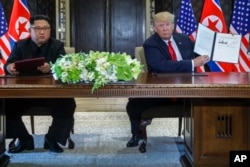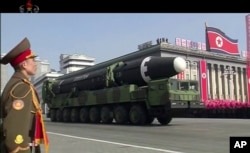U.S. President Donald Trump announced during his State of the Union Address Tuesday that he would next meet North Korean leader Kim Jong Un in Vietnam on February 27-28.
"As part of a bold new diplomacy, we continue our historic push for peace on the Korean Peninsula,” Trump said.
In his speech, the President also acknowledged the road toward denuclearization remains long, “Much work remains to be done, but my relationship with Kim Jong Un is a good one," he said.
The formal announcement of the second U.S. - North Korea summit came as South Korea celebrated the Lunar New Year. While government offices were closed for the national holiday, South Korean presidential spokesperson Kim Eui-kyeom said Seoul hoped the two countries would make progress when they met later this month.
Kim, speaking to reporters, said, "Vietnam and the United States used to point a gun and knife at each other, but now they are friends. We expect Vietnam to be the best venue to host the event for North Korea and the United States to make history."
Vietnam importance
President Trump’s announcement of the summit dates and location were not a surprise. U. S. Secretary of State Mile Pompeo had previously confirmed that President Trump would meet Kim in late February in Asia.
However, analysts told VOA that the length of the next summit and its location have special meaning.
Tufts University Kim Koo-Korea Foundation Professor of Korean Studies, Sung-yoon Lee, said as Saigon was falling in 1975, Kim Il Sung ”visited Beijing and asked Mao Zedong and other officials to help him do what Hanoi was doing… after having compelled the United States to sign a peace agreement to leave.”
He said, “That is the perfect Vietnam model for the Kim regime.”
Lee said Trump is essentially saying, “Hey, look at Vietnam. We [the United States] had a very hostile relationship with Vietnam in the past, but we've patched over things,” adding, “Vietnam has remained single-party communist dictatorship, but it's grown rich. You too can do it.”
In addition, the Center for the National Interest Directory of Korea Study’s Harry Kazianis said the length of the upcoming summit is of note and may indicate “something big.”
“I think there is work around a peace declaration,” Kazianis said. “I also think that the North Koreans have been quite serious and telegraphing to the United States, to Seoul, really to anybody, that will listen, that they want some sort of sanctions relief.”
As evidence to support his theory, Kazianis points to comments made last week by U.S. SpecialRepresentative for North Korea, Stephen Biegun.
“Therefore it is all the more urgent that we engage diplomatically with North Korea to see if we can change the trajectory of their policies, by changing the trajectory of our own. And that's what we're trying to do,” said Biegun while speaking at Stanford University.
Kazianis said that “from a rational perspective,” to move North Korea toward denuclearization, there “needs to be an action for action sort of situation,” and Biegun’s remarks seem to indicate a shift in policy.
In his remarks though, Biegun remained firm, “President Trump has made clear, both to North Korea, as well as to our team that he expects significant and verifiable progress on denuclearization -- actions that are bold, and real to emerge from that next summit.”
But Lee indicated concern when Biegun said, “President Trump is ready to end this war. It is over. It is done. We're not going to invade North Korea.”
Lee said that while the Korean War did not end in a formal peace treaty in 1953, that does not mean the peninsula has been in a constant state of war, but rather an “imperfect peace.”
To “say we have to end this war, right now 70 years of hostility. That is to fall right into Kim Jong Un's hands because that's North Korean verbiage,” Lee said, adding that a de facto peace has been maintained through deterrence.
If the United States were to initiate a peace agreement with North Korea, Lee said that plays into Kim Jong Un’s hands and gives him the advantage in talks.
Kazianis disagrees, noting both Kim and Trump have domestic audiences watching.
“You've got to figure out some way to package this (the summit) where both sides get a win,” and for Kazianis, that means an end to the Korean War.
“Both sides saying that the war is over through a peace declaration makes a lot of sense, and we all know the war is over and both sides get that clear win that they can go back home,” he said.
War claims
During the State of the Union address, Trump said, “If I had not been elected President of the United States, we would right now, in my opinion, be in a major war with North Korea."
Lee said the President’s assertion is untrue, “Because everyone says the Korean War ended on July 27, 1953, not with a formal peace treaty, but a ceasefire agreement.”
Kazianis said when Trump made comments, as he did on August 8, 2017, “North Korea best not make any more threats to the United States. They will be met with fire and fury like the world has never seen;” the President “inflamed tensions.”
He added that looking at the interaction between Washington and Pyongyang from the “mid-2000s” both nations were on a trajectory, with North Korea testing intercontinental ballistic missiles, that would eventually create some “problems in 2017.”
But “If Hillary Clinton had [won the 2016 election],” said Kazianis, “there's a lot of archival research... that does suggest that she would have had a tougher line as well [against North Korea]. But I don't think she would be calling for fire and fury and making some of these very, very intense statements.”










